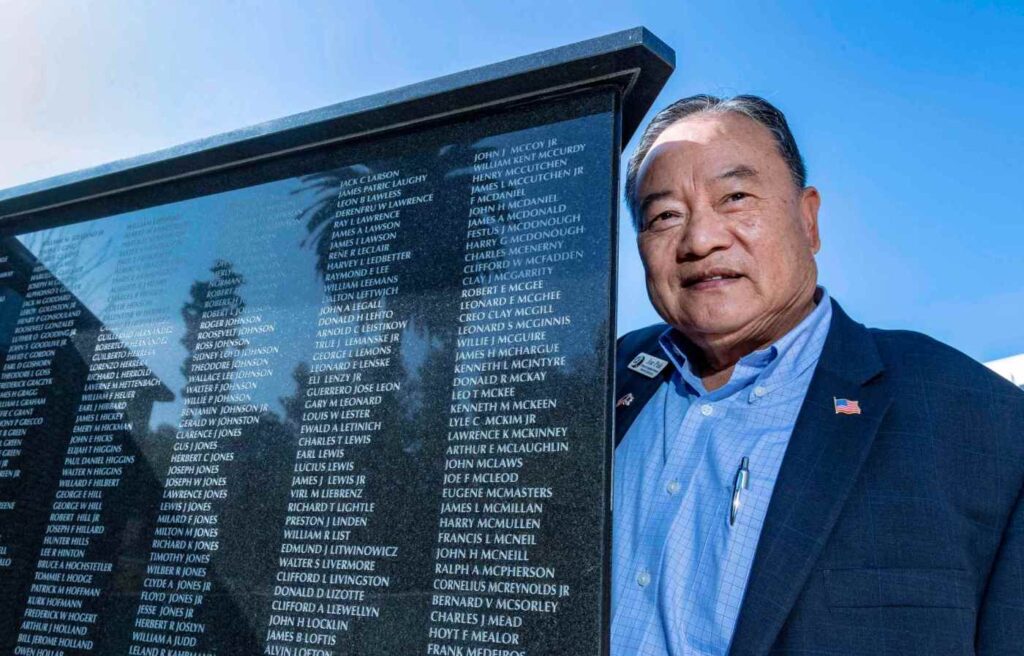
Seventy years ago, U.S. troops were engaged in the Korean conflict. It has been called the forgotten war but is making headlines lately.
A new memorial
Last Veterans Day, the first Korean War Memorial that lists the names of more than 36,000 U.S. military members killed in the war was unveiled in Fullerton. The names are on five large, black granite stars, each listing 7,500 service members who died.
The $1 million cost for the wall was paid for by donations, including by the South Korean government.
Orange County resident Joe Pak was the inspiration for the newly dedicated memorial that took a dozen years to become reality.
Pak, who had been in the U.S. for 52 years, told reporters at the dedication, “Even with the nearly 37,000 American casualties, the Korean War has been referred to as the ‘forgotten war.’ It is not a forgotten war to us.”
A new film
“Devotion” is based on Adam Makos’ bestselling book, “Devotion: An Epic Story of Heroism, Friendship, and Sacrifice.” According to Military.com, “Devotion” will be the first movie about the Korean conflict from a major studio since “Pork Chop Hill” starring Gregory Peck in 1959.
Lt. Jesse L. Brown, left, was the first African American aviator for the U.S. Navy.
Brown and his squadron were dispatched to the Chosin Reservoir, where approximately 100,000 Chinese troops had surrounded 15,000 U.S. troops. Brown and other pilots flew dozens air support missions to prevent the Chinese from overrunning the U.S. troops.
After Brown was shot down by enemy fire, his wingman Thomas Hudner crashed his own plane in an attempt to rescue his friend. Hudner was awarded the Medal of Honor for his actions at the Battle of Chosin Reservoir on Dec. 4, 1950.
The film opens Thanksgiving weekend.
The U.S. Navy named a ship in honor of Lt. Jesse L. Brown. It was commissioned in 1973 and decommissioned in 1994.
Korean War Veterans Memorial In Washington, D.C.
The National Park Service and the Korean War Veterans Memorial Foundation are rehabilitating the 25-year-old memorial and started construction on the Wall of Remembrance. The Wall of Remembrance is a new, permanent addition to the memorial and will include the names of 36,574 American servicemen and more than 7,200 members of the Korean Augmentation to the U.S. Army who gave their lives defending the people of South Korea. It was dedicated July 27, 2022.
The memorial has a walled triangle with 19 stainless steel statues designed by Frank Gaylord. Each statue is taller than 7 feet. The statues face the Pool of Remembrance, a shallow circular pool 30 feet in diameter lined with black granite and surrounded by a grove of linden trees with benches.
A look at the conflict
Korea was first divided after Japan was defeated in 1945. The Soviets protected the North and the American allies the South. The two sides failed to agree on one governmental system for the whole region, and the two nations have become vastly different.
On June 25, 1950, the Soviet-supported North Koreans crossed the 38th parallel and attacked the pro-Western Republic of Korea. American troops entered the war on South Korea’s behalf to prevent what was seen as a spread of communism. When the war came to an end three years later, 5 million soldiers and civilians had lost their lives. The Korean Peninsula remains divided today.
China and the Soviet Union
After the partition of the Korean Peninsula in 1945, the Soviet Union was instrumental in purging its zone of political dissidents and supporting the ruling Communist Party. The USSR backed communist leader Kim Il-Sung’s 1950 invasion of South Korea. When the invasion was beaten back, China sent a formidable expeditionary force into Korea, first to drive the U.N. Command out of the north.
Within three months of the initial attack, North Korea engulfed nearly the entire Korean peninsula. The U.S. called for a meeting of the United Nations Security Council and condemned the invasion. In September that same year, the U.N. sent forces composed of troops from 15 nations to the peninsula to stop the communist advance. The forces, led by U.S. Gen. Douglas MacArthur, pushed north back to Seoul near the 38th parallel. Despite warnings from China, the U.N. forces continued north, nearly reaching the Yalu River, which boarders China and the Korean peninsula. China reacted by sending troops into North Korea, which quickly forced MacArthur’s troops to retreat behind the 38th parallel.
Jet warfare
By the end of hostilities, F-86 Sabre pilots had shot down 792 Soviet MiGs, with a kill ratio of about 8:1. More than 5,500 F-86 fighters were built in the U.S. and Canada. Air forces of 20 other nations flew the F-86.
Did we declare war?
Technically no. The U.S. military led the UNs’ expeditionary force. The UN itself cannot declare war. Consequently, the conflict in Korea did not technically constitute a war.
More than 30,000 U.S. troops died and more than 100,000 were wounded.
A look at veterans by the numbers
Sources: U.S. Department of State, history.com, Department of Defense, Military.com, National Park Service, SCNG staff reports Photos from Wikimedia Commons unless otherwise noted
